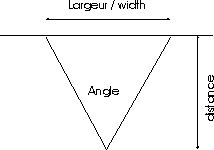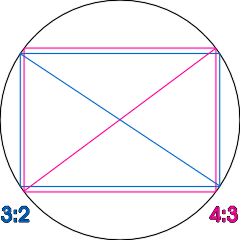How
to find out?
With the coming
of digital still cameras, the photographs are comparing
lenses to the film camera ones, and use the focal length
of the 35mm film cameras as reference. Thus, because there
is a great number or digital sensors, the focal length of
digital cameras lenses indicated doesn't really let the
customer to know if it is a wide angle lens or a normal
one.
It is the
same for the micro video cameras.
|
|
- It
should be more rational to specify
the lenses with their horizontal
angular field of view. So,
instead to say a 35mm, we should say a 54° lens.
- The hereunder tables give the angular
fields of view of different lenses.
- See also the Excel table angular_field.xls
- diagonal angle draw in the
diagonal direction
- horizontal angle draw in the horizontal
width of the landscape frame.
- vertical angle draw in the vertical
height
-
|
For measuring
field of view:
- Set
a marked rule facing the camera. The figures must be large
enough to be readable: 15mm or 20mm high.
- Tilt the
camera depending on the field angle to determine: horizontal,
vertical, or diagonal.
- Read the
two last marks at each end
- Measure the
distance D from the camera to the rule.
- Subtract
the smaller mark to the greater to get the field width
W.
-
- Calculate
the angle of field A with the formula:
- A = 2 x ATN ((W/2)/D)
- or with this one:
- A = 180 x W / pi /
D pi = 3.14116
ATN is the mathematical function "arc tangent"
If you don't have a scientific calculator machine, you can use
the Excel table: angular_field.xls
If you can't calculate, send me your
measures, and I will calculate them for you. |
|

Graphic determination
Draw the width
X
From the center
of X, draw the distance D
Link the ends of
segments D and X
Measure the angle
with a protractor
When drawing this
graph with 10cm for 1m, the accuracy is of 1°
|
|
|
|
35mm
FILM CAMERAS
dimensions of
film
aspect ratio
width height diagonal
36 mm 24
mm 43 mm 1,5
focal ....................angle....................
mm diagonal horizontal vertical
21 92° 81° 59°
24 84° 74° 53°
28 75° 65° 46°
35 63° 54° 38°
40 57° 48° 33°
50 47° 40° 27°
70 34° 29° 19°
85 29° 24° 16°
105 23° 19° 13°
135 18° 15° 10°
150 16° 14° 9°
200 12,3° 10,3° 6,9°
210 11,8° 9,8° 6,5°
300 8,2° 6,9° 4,6°
400 6,2° 5,2° 3,4°
500 5,0° 4,1° 2,7°
600 4,1° 3,4° 2,3°
|
|
DIGITAL
CAMERAS sensor 1/1,8
pixels:
2048x1536 (3Mpix)
or
2272x1704 (4Mpix)
dimensions
of sensor aspect
ratio
width height diagonal
7,18mm 5,38
mm 8,93 mm 1,33
focal ....................angle....................
mm diagonal horizontal vertical
5,6 77° 65°
51°
7,0 65° 54° 42°
7,8 60° 49° 38°
8,0 59° 48° 37°
9,8 49° 40° 31°
13,7 36° 29° 22°
16,6 30° 24° 18°
21 24° 19° 15°
28 18° 15° 11°
30 17° 14° 10°
32 16° 13° 10°
It must be noted that the digital cameras
have seldom very wide angle lenses. |
-
- Product information
of digital cameras
-
The product
informations of digital cameras almost always describe the
lenses of P&S digital cameras as equivalent focal distance
of 35 mm film cameras. This equivalence is done by comparing
the diagonal field angle between the 35 mm film and the
digital camera lens. But if the focal distances are equivalent,
the image aspect ratios are different, thus the horizontal
and vertical fields are slightly different.
For example
the horizontal angular field is 54° in the 3:2 or 1.5
aspect ratio and is 52° in 4:3 or 1.33 aspect ratio
for a 35 mm focal length of 24x36 mm film camera or digital
equivalent.
|
|

|
-
- Equivalent focal distance
of SLR cameras
-
The camera
makers and the photographs have found practical to express
the ratio of the image converter sizes. The image converters
are the 24 x 36 sensitive area and the digital sensors.
The usual reference being the 26 x 36 film image which image
aspect ratio is 3:2 or 1.5, the ratio is calculated with
digital sensors. It express the ratio between focal length
to get an equivalent field of view and it is called "focal
length multiplier".
Attention: Do not confuse the focal length multiplier
and the aspect ratio!
|
|
As example
let see the sensor of digital SLR Pentax K10D which size
is 25,1 x 17,6 mm but which effective pixels area is 23,5
x 15,7 mm. the diagonal of this effective area is 28,26
mm to compare to the diagonal of 24 x 36 film which is 43,27
mm. the ratio 43.27 / 28.26 gives the focal length multiplier
1,5.
Thus a lens
35mm focal length mounted on the K10D body will produce
an image with the same field of view as a 50 mm lens on
a 35 mm film camera.
|

